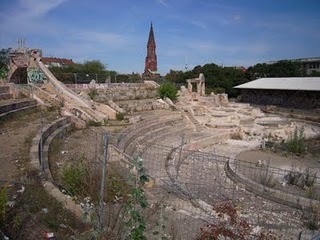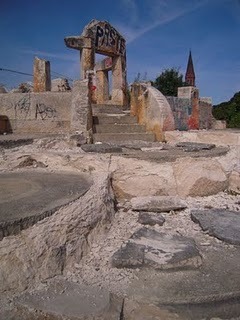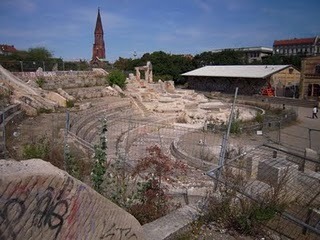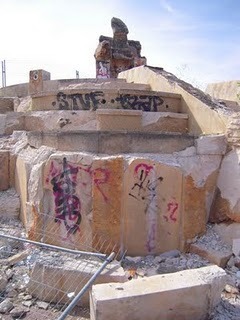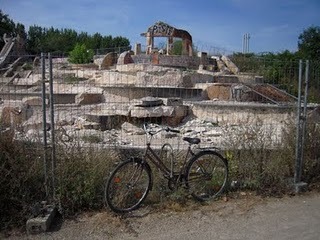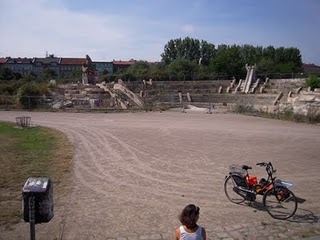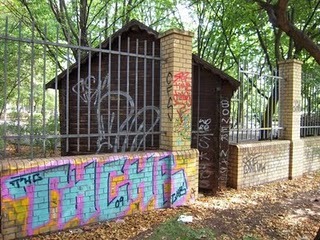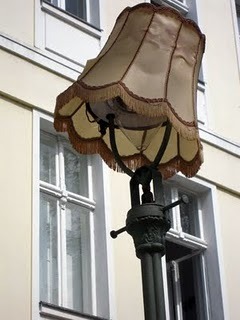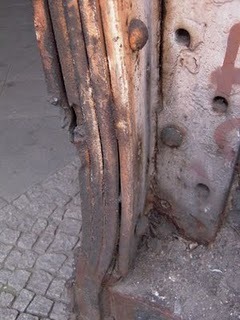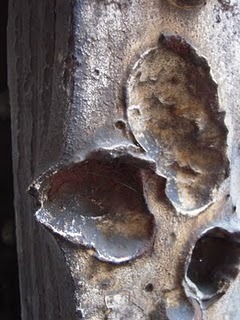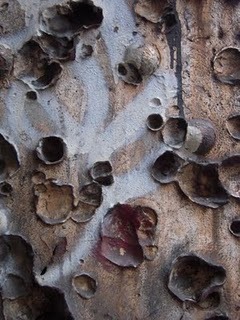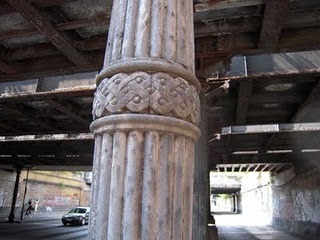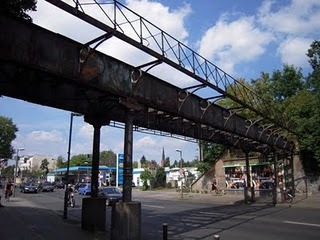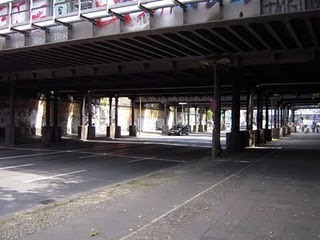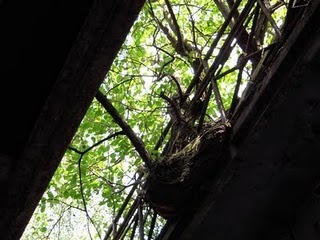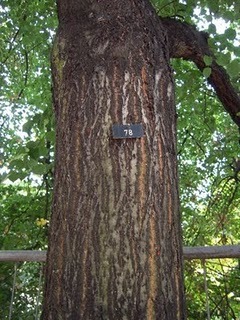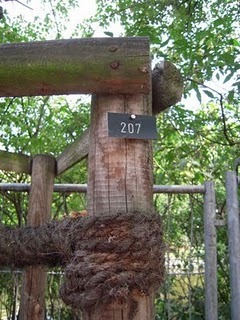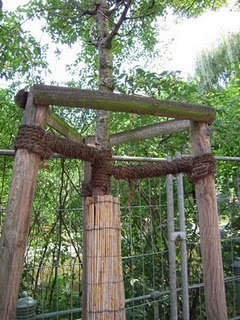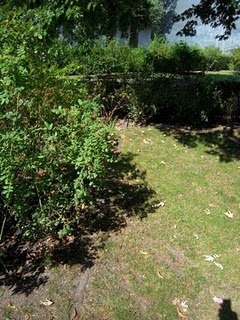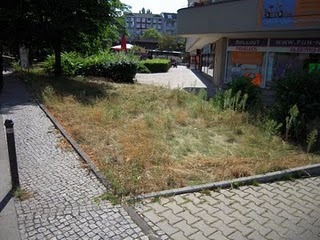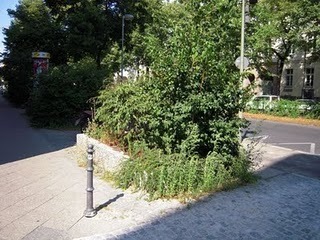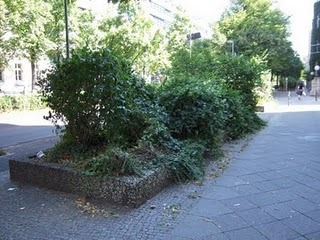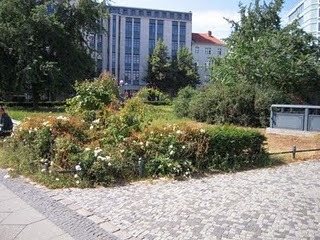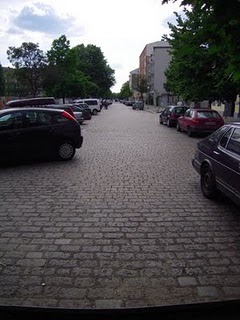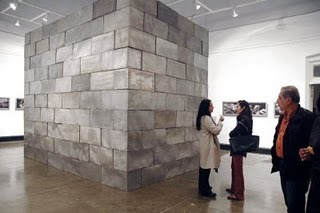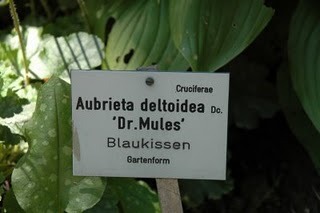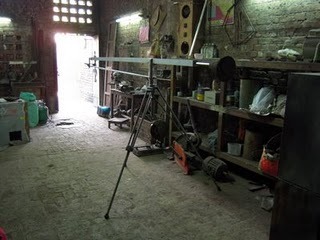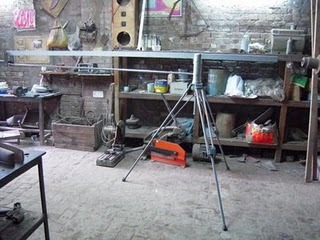“A Walk in the Woods” Berlin, 2009.
Gorlitzer Park, Kreuzberg, Summer 2009
People sit on it’s steps and gaze out into this barricaded ruin. The barricades add to it’s sense of dissaster and potential threat. It becomes a complete dead-zone. I have heard the project is still in litigation.
Intended as a water-garden of terraces and cascades, the wrong stone was selected and the decay of the stone began with the first frosts, it was never completed.I am hoping a local collaborator will shed more light on this. I have both video and still documentation. What the work may be is still to be resolved. I would consider intervening in the site itself.
Bomb Damage, Yorkstrasse, Berlin.
Some abandoned railway bridges and some still in use. Frequently passed on our way into Transart, summer 2009. I didn’t get to make work from them on the residency but afterwards I went back and documented them with stills and video.
Similar to the Lola piece they too bear witness.There is so much damage to the bridges and the surrounding walls. I tried to research why they were targeted to this extent, nothing conclusive as yet, although I did find logs of bombing raids on the area. What I took to be C.I. sections must be steel given the extent of their gouging and distortion under the effects of the blasts. Nature is reclaiming much of the surrounding post-industrial sites and railway sidings. Trees are actually growing into the edges of these fabricated metal bridges. I also find the language of the ornamental capitals of some of the columns interesting.
Berlin Landscape Maintenance
Berlin Residency Summer 09: “Run Lola Run”
Cuvrystrasse then and today, where Lola was shot in the film.
I undertook additional research for this piece in Berlin after the residency, amassing more photographs around Cuvrystrasse and interviewing a number of residents. I am still looking for ways to get finished work out of this enquiry, which is by no means over.
Ginko leaves and fruit from the area
The remains of the Yam club, the Lido remains nearby.
I have yet to decide how to formalize this work. Am I looking for a small book/note-book like piece, short video, slide-show or graphic work(s)? It’s important to me to finish this as a link into next summer’s show and residency in Berlin.
Research title update
<meta name=”Title” content=””> <meta name=”Keywords” content=””> <meta equiv=”Content-Type” content=”text/html; charset=utf-8″> <meta name=”ProgId” content=”Word.Document”> <meta name=”Generator” content=”Microsoft Word 2008″> <meta name=”Originator” content=”Microsoft Word 2008″>
I intend to take a very expanded view of the garden as culture and nature (including small farms, orchards and the landscape of the cities of Lahore and Karachi).
To investigate the possibility of obscured layers of garden practice and concepts that may originate in the land and region itself.
I will include sites in Baltistan as they would seem to have a very different conception of the garden and hopefully I will continue to work there some of this year.
-the poppy fields of the far north, what fantastic gardens they might be?
The current renaming of streets (and prior namings under other administrations) the removal of all Raj statuary and re-appropriation of sites Victoria’s memorial is now Jinnah sister memorial in Lahore).
My emphasis is probably to be on the soft-landscape rather than an analysis of architectural elements, though I’m sure that will form a part of the research.
Perhaps the result would be to argue that the naming of most plants and any particular conception of the garden will always be layered with obscured influence.
Untitled
Research and studio 2009-2010
Draft title: “Working the Garden, a consideration of the garden in contemporary Pakistan”.
Towards my studio work “A Taxonomy of Eden” I will be researching gardens and urban landscape in contemporary Pakistan. This will include varying attitudes to the notion of nature, wilderness and the paradise garden. Also the legacy of aging colonial parks. Besides readings (see bibliography below) I will interview a cross section of contemporary society from career gardeners in Lahore’s parks, agricultural workers, religious scholars (and lay practitioners from various religions and sects) the educated and the less educated in the city and countryside of Lahore and Karachi (possibly further afield also). From nursery owners, the head of the Punjab Horticultural Authority to jobbing residential gardeners in the Defence housing authorities of Karachi and Lahore. This will follow a format of recordings, translations, transcriptions and analysis. Also photography and some video. I work as a freelance horticultural consultant in Pakistan and have done so for the past 21 years. My clients currently include Agha Khan Cultural Services Pakistan, with whom I am working on several restoration projects, including the uplift of the North Circular Park belt around Lahore’s old city.
(Sacred Texts. Garden Design. Garden History. Landscape. Popular Culture. Decorated Transport. Trees on the edge between nature and culture. Motifs. Carpets. Ageing colonial public parks in Lahore. The culture of the Mali.)
Draft Bibliography (11 July 2009) Part Questia, part owned.
Albinia, Alice. Empires of the Indus. John Murray. 2008.
Anderson, Earl R. Folk-Taxonomies in Early English. Madison, NJ: Fairleigh Dickinson University Press, 2003.
Anderson, Edgar. Plants, Man and Life. Boston: Little, Brown & Company, 1952.
Anesaki, Masaharu. Art, Life, and Nature in Japan. Boston: Marshall Jones Company, 1933.
Arber, Agnes. Herbals, Their Origin and Evolution: A Chapter in the History of Botany, 1470-1670. Cambridge, England: University Press, 1938.
Aubrey, James R., ed. John Fowles and Nature: Fourteen Perspectives on Landscape. Madison, NJ: Fairleigh Dickinson University Press, 1999.
Aydon, Cyril. Charles Darwin, His life and times. Running Press. 2008.
Bailey, L. H. How Plants Get Their Names. New York: Dover Publications, 1963.
Barton, Gregory Allen. Empire Forestry and the Origins of Environmentalism. Cambridge, England: Cambridge University Press, 2002.
Baydawi, Abd Allah, and Mahmud Isfahani. Nature, Man and God in Medieval Islam: ‘abd Allah Baydawi’s Text, Tawali’ Al-Anwar Min Matali’ Al-Anzar, along with Mahmud Isfahani’s Commentary, Matali’ Al-Anzar, Sharh Tawali’ Al-Anwar. Translated by Calverley, Edwin E. and James W. Pollock. Edited by Edwin E. Calverley and James W. Pollock. Vol. 2,. Boston: Brill, 2002.
Bedford, Henry F. Citizen Politics and Nuclear Power Citizen Politics and Nuclear Power. Amherst : University of Massachusetts Press, 1990.
Bell, Simon. Landscape: Pattern, Perception, and Process. New York: Spon Press, 1999.
Benson, Lyman D. Plant Taxonomy: Methods and Principles. New York: Ronald Press Co., 1962.
Bracey, H. E. English Rural Life: Village Activities, Organisations, and Institutions. London: Routledge and Paul, 1959.
Brichto, Herbert Chanan. The Names of God: Poetic Readings in Biblical Beginnings. New York: Oxford University Press, 1998.
Brother, Nan. Men and Gardens. 1st ed. New York: Alfred A. Knopf, 1956.
Burden, Robert and Stephan Kohl, eds. Landscape and Englishness. Amsterdam: Rodopi, 2006.
Busch, Lawrence, William B. Lacy, Jeffrey Burkhardt, Douglas Hemken, Jubel Moraga-Rojel, Timothy Koponen, and José De Souza Silva. Making Nature, Shaping Culture: Plant Biodiversity in Global Context. Lincoln, NE: University of Nebraska Press, 1995.
Campana, Richard J. Arboriculture: History and Development in North America. East Lansing, MI: Michigan State University Press, 1999.
Carr, David M. The Erotic Word: Sexuality, Spirituality, and the Bible. New York: Oxford University Press, 2003.
Conlogue, William. Working the Garden: American Writers and the Industrialization of Agriculture. Edited by Jack Temple Kirby. Chapel Hill, NC: University of North Carolina Press, 2001.
Dale, Stephen F. The Garden of the Eight Paradises: Babur and the Culture of Empire in Central Asia, Afghanistan and India (1483-1530). Boston: Brill, 2004.
Don, Monty. Around the World in Eighty Gardens. Weidenfeld & Nicolson. 2008.
Dawkins, Richard. The God Delusion. Bantam Press. 2006.
Ereshefsky, Marc. The Poverty of the Linnaean Hierarchy: A Philosophical Study of Biological Taxonomy. Cambridge, England: Cambridge University Press, 2001.
Evans, David. A History of Nature Conservation in Britain. London: Routledge, 1997.
Eyler, Ellen C. Early English Gardens and Garden Books. Ithaca, NY: Cornell University Press, 1974.
Foerster, Norman. Nature in American Literature: Studies in the Modern View of Nature. New York: Macmillan, 1923.
Fry, Michael. A Manual of Nature Conservation Law. Oxford: Oxford University, 1995.
Gardens of Prehistory: The Archaeology of Settlement Agriculture in Greater Mesoamerica. Edited by Thomas W. Killion. Tuscaloosa, AL: University of Alabama Press, 1992.
Gatta, John. Making Nature Sacred: Literature, Religion, and Environment in America from the Puritans to the Present. New York: Oxford University Press, 2004.
Geikie, Archibald. The Love of Nature among the Romans during the Later Decades of the Republic and the First Century of the Empire. London: John Murray, 1912.
Gersdorf, Catrin and Sylvia Mayer, eds. Nature in Literary and Cultural Studies: Transatlantic Conversations on Ecocriticism. Amsterdam: Rodopi, 2006.
Grady, Wayne, ed. Bright Stars, Dark Trees, Clear Water: Nature Writings from North of the Border. Boston: David R. Godine, 1995
Harada, Jiro. The Lesson of Japanese Architecture. Revised ed. London: Studio Limited, 1954.
Hatton, Richard G. Handbook of Plant and Floral Ornament: Selected from the Herbals of the Sixteenth Century, and Exhibiting the Finest Examples of Plant-Drawing Found in Those Rare Works, Whether Executed in Wood-Cuts or in Copperplate Engravings, Arranged for the Use of the Decorator. New York: Dover Publications, Inc., 1960.
Harberd, Nicholas. Seed to Seed. Bloomsbury. 2006.
Hawks, Ellison, and G. S. Boulger. Pioneers of Plant Study. New York: The Macmillan Company, 1928.
Henderson, John. Hortus: The Roman Book of Gardening. New York: Routledge, 2004.
Hoffenberg, Peter H. An Empire on Display: English, Indian, and Australian Exhibitions from the Crystal Palace to the Great War. Berkeley, CA: University of California Press, 2001.
Howes, Laura L. Chaucer’s Gardens and the Language of Convention. Gainesville, FL: University Press of Florida, 1997.
Huggett, R
ichard John. Geoecology: An Evolutionary Approach. New York: Routledge, 1995.
Hunt, John Dixon. Garden and Grove: The Italian Renaissance Garden in the English Imagination, 1600-1750. 1st ed. Philadelphia: University of Pennsylvania Press, 1996.
Huth, Hans. Nature and the American: Three Centuries of Changing Attitudes. Lincoln, NE: University of Nebraska Press, 1990.
Jacobs, Noah Jonathan. Naming-Day in Eden: The Creation and Recreation of Language. New York: Macmillan, 1958.
Keulartz, Jozef. Struggle for Nature: A Critique of Radical Ecology. London: Routledge, 1998.
King, Amy M. Bloom: The Botanical Vernacular in the English Novel. New York: Oxford University Press, 2003.
Lehner, Ernst, and Johanna Lehner. Folklore and Symbolism of Flowers, Plants and Trees. New York: Tudor Publishing, 1960.
Leiss, William. The Domination of Nature. Montreal: McGill-Queen’s University Press, 1994.
León, Luis De. The Names of Christ /. Translated by DurÁn, Manuel and William Kluback. New York: Paulist Press, 1984.
Luger, Michael I., and Harvey A. Goldstein. Technology in the Garden: Research Parks and Regional Economic Development. Chapel Hill, NC: University of North Carolina Press, 1991.
Merchant, Carolyn. Reinventing Eden: The Fate of Nature in Western Culture. New York: Routledge, 2003.
Milton, Kay. Loving Nature: Towards an Ecology of Emotion. London: Routledge, 2002.
Noble, David W. The Eternal Adam and the New World Garden: The Central Myth in the American Novel since 1830. New York: Braziller, 1968.
Pavord, Anna. The Naming of Names, The search for order in the world of plants. Bloomsbury. 2005.
Prance, Ghillean and Mark Nesbitt, eds. Cultural History of Plants. New York: Routledge, 2004.
Reed, Howard S. A Short History of the Plant Sciences. Waltham, MA: Chronica Botanica, 1942.
Reed, Michael. The Landscape of Britain: From the Beginnings to 1914. London: Routledge, 1997.
Reynolds, Richard. On Guerrilla Gardening. Bloomsbury. 2008.
Robbins, R. H. A., ed. Religio Medici: Hydriotaphia: And, the Garden of Cyrus. Oxford: Oxford University, 1972.
Rojas, Carlos. The Garden of the Hesperides. Translated by Glad, Diana. Madison, NJ: Fairleigh Dickinson University Press, 1999.
Scidmore, Eliza Ruhamah. Winter India. New York: The Century Co., 1904.
Simmons, I. G. Interpreting Nature: Cultural Constructions of the Environment. New York: Routledge, 1993.
Stave, Shirley A. The Decline of the Goddess: Nature, Culture, and Women in Thomas Hardy’s Fiction. Westport, CT: Greenwood Press, 1995.
Gill, Simryn. Pearls. Raking Leaves. 2008.
Thomas, Julia Adeney. Reconfiguring Modernity: Concepts of Nature in Japanese Political Ideology. Berkeley, CA: University of California Press, 2001.
Tillotson, Geoffrey. Pope and Human Nature. Oxford: Clarendon Press, 1958
Trowbridge, Peter J., and Nina L. Bassuk. Trees in the Urban Landscape: Site Assessment, Design, and Installation. Hoboken, NJ: John Wiley & Sons, 2004.
Troyanov, Iliya. The Collector of Worlds. Faber & Faber. 2008 (Novel).
Turrill, W. B, ed. Vistas in Botany. New York: Pergamon, 1959.
Veenhuizen, Rene Van, ed. Cities Farming for the Future: Urban Agriculture for Green and Productive Cities. Ottawa: International Development Research Centre, 2006.
Verdoorn, Frans, ed. Plants and Plant Science in Latin America. Waltham, MA: Chronica Botanica, 1945.
Webb, Richard E. The Accident Hazards of Nuclear Power Plants. Amherst, MA: University of Massachusetts Press, 1976.
Wiggin, Kate Douglas Smith. My Garden of Memory: An Autobiography. Boston: Houghton Mifflin Company, 1923.
Studio Practice: “A Taxonomy of Eden”
Building upon “The Garden of Babel” 2009 as the initial format I will work towards examining aspects of various sacred texts in translation. Those of the Abrahamic religions including Judaism, Christianity and Islam and possibly others in the broad grouping in relation to notions of the garden of Eden. In this respect I will be particularly focusing on the plants mentioned there. Using this with allied horticultural enquiry, and in consultation with various international scholars I would work to build a plausible taxonomy of Eden. The works may be gridded digital prints of botanical and zoological accession labels, as are to be found in Zoos and botanical gardens around the world. My work on “The Garden of Babel” revealed a pleasing lack of scientific rigour in the world of plant taxonomy. I would find reasonable botanical approximations of specifically mentioned plants in Eden (these will be real plants). I will aim for around 180-300 plants in a work. There may be one or more works. I will then make the labels in etched plastic laminates, as authentic botanical labels. Photograph them in particular settings, as I have learnt from the making of “The Garden of Babel”. These may then be composed as grids and printed as large C-prints. How the work will play out in other forms such as performance, video, audio, texts, woven carpets or illuminated manuscripts or their digital equivalents remains to be seen.
Notes/alternatives: Performative: (Autobiography/Horticulture/Video) The Lawn Mower. New Liberal Mowers, Lahore, producing Ransomes vintage 1950’s machines, monstrous machines evolving on their own paths away from their colonial models. Lawn grass is the white mans burden? Myself pulling a large mower around a massive lawn I have made, (re: Un Chien Andalou, the harness pulling all the mass of culture) I encounters at various Stations around the route (Columns of Stewardship for example). Garden machines, garden technologies, male (Machinery) and female (the land itself). A sort of Cremaster of the garden approach. Exploring the history of the lawn: it speaks of class aspirations, industrialization has allowing broad access to the privilege of the lawn, once the domain of the landed gentry. To make my own lawn-mowers and perform with them? (Very autobiographical). Greens, British racing greens (Brooklands, where I studied), English mower greens, the Suffolk Punch mower. Water cans, columns of Stewardship, a journey around the Tarogil lawns. Lawrence Mali’s. Howard Gem rotator’s. My grandfather’s horticultural medal. Events in the journey around the Tarogil play ground lawn, journeying on a ride-on mower?Go down into the ground too, digging into the soil. Incorporate the “12.2.42” boxes in the fields of Tarogil. Radical garden design, guerilla gardening? Imran’s early chainsaw, Bhor tree (at home), climbing trees, tree work equipment (I used to work as a tree-surgeon). Fruit bat counting Mali’s, Lawrence Gardens, Cantt. Water Towers. The canals, barrages and bal mitti of Punjab. Garden tools. Lahore Compost at the city dump. Shalimar Gardens in disarray. Punjab Horticultural Association, my meetings with them. Garden plans, graphics, plant taxonomy.
How to build upon “The Garden of Babel” work? Car number plate grids? Hierarchies. Another trajectory.
Lahore,
July 2009.
Transart Submission: 15th June 2009
Research Synopsis 2009
Research Proposal 1.
Studio Practice: The Autobiographical and the public.
In relation to the above enquiry and as an extension of my practice in 2008-2009 I would continue to make autobiographical work. I see the task in hand now to be a full integration of my life, as outsider and “other” in Pakistan with broader societal and global concerns. The thread of this may be taken up from the “Domestic Displacements” work I undertook in Lahore in May and June of 2009.
Research-Proposal 2.
Building upon “The Garden of Babel” 2009 as a format I would initially work towards examining various sacred texts in translation. Those of the Abrahamic religions including Judaism, Christianity and Islam and possibly others in the broad grouping in relation to notions of the garden of Eden. In this respect I would be particularly focusing on plants mentioned there. Using this with allied horticultural enquiry, and in consultati0n with various scholars I would build a taxonomy of Eden. The works may be grided digital prints of botanical and zoological accession labels, as are to be found in Zoos and botanical gardens. I would have to create reasonable approximations of specifically mentioned plants of Eden, I would aim for around 180-300 plants per work. I would then make the labels in etched plastic laminates, as authentic labels. Photograph them in particular settings, as I have learnt from the making of “The Garden of Babel”. These would then be composed as grids and printed as large C-prints. How the work may play out in other forms such as texts, woven carpets or illuminated manuscripts or their digital equivalents would remain to be seen.
The Autobiographical
HALF-LIFE
New Work
David Alesworth | Huma Mulji
Zahoor ul Akhlaq Gallery
National College of Arts | Lahore | Pakistan
me. This sculptural installation has other resonances, the formality of artists such as (late period) David Smith, Donald Judd and Karl Andre. This is slightly tongue in cheek reference to such minimalist concerns, through the lens of time and place. This is another prayer for sanity and peace, the way my “Two Bombs Kiss” was in the early ‘90’s. It was within the unshielded CP-1 reactor that plutonium production became a practical proposition. “Seaborg, (the discoverer of Plutonium) was asked to suggest a name for the element he had discovered. He decided to respect the tradition begun with uranium, named for the planet Uranus, then neptunium — the 93rd element, found in 1940 — for Neptune. As the next planet in the solar system was Pluto, he suggested the new element be called plutonium. No one thought to point out that the deity after which the planet Pluto was named was the Greek god of hell, the Roman god of death.” All the Plutonium on the planet now (a completely man‐made element) is around 50 tons; enough, if judiciously employed, to entirely destroy life on the earth. It is undoubtedly the most toxic substance in existence. I see “12.2.42” as part tribute (to scientific endeavor) and part warning (of the imperfect nature of mankind’s knowledge). The smallness of mankind’s achievements set against the vastness of creation. The ultimate failure of all technologies and civilization itself. It is a Vanitas sculpture. It critiques the arrogance of scientific knowledge. I half suspect this world will be sucked through the eye of an atom sized black‐hole, produced in the new Cern accelerator experiements. What a suitable ending it would be for this planet, wrecked as it is, by mankind’s insatiable greed. The units are identical but also quite distorted from the heat of their welding. The proportions of 14 x 14 x 28 inches directly address the scale of one’s body. I investigated other sizes and ratios to arrive at this. It is to do with one’s span. I realize these are very much the concerns of the early minimalists, like Caro, who was once Henry Moore’s protégé. The idea of span and of being body‐scaled are terms that could be right out of Moore’s own vocabulary. Though such concerns are readily discernible in ancient Egyptian sculpture (all of the canonical works.) My undergraduate dissertation was on the cannon of proportion in ancient Egyptian sculpture. I welcome the “wobble” that sign or life. It’s the imperfection that makes energy flow in the work, something I’ve long used in my practice. A tension between stillness and movement. There’s a correlation between the persistence of an official record and that of radioactive waste. I’m thinking of Half-Life as the link between the forest of files (The Record Room Series), undying, unending and uncountable, and the beginning of the nuclear age. Taking Fermi’s first pile CP‐1 as the beginning of this as it was here that Plutonium was first produced, albeit in tiny quantities. On that day that CP-1 first went critical for only 28 minutes and Plutonium was produced in its nuclear flux. Leo Szilard lingered on the balcony until most people had left, then turned to Fermi, shook his hand, and said that he thought the day would go down as a “black day in the history of mankind.” This cube of steel boxes is as much a play with the proportions of the room and scale of the body as it is a reference to nuclear power. Waste from Chicago Pile1 was buried in nearby woodland, this was not a fortuitous beginning to the nuclear age.
about what the board calls a “Second Nuclear Age” marked by grave threats. The board also cited “escalating terrorism, and new pressure from climate change for expanded civilian nuclear power that could increase proliferation risks.” The Doomsday Clock is now set at seven minutes to midnight. The Doomsday Clock is a symbolic clock face that the Bulletin has maintained since 1947 at its headquarters on the campus of the University of Chicago. It uses the analogy of
the human race being at a time that is a “few minutes to midnight” where
midnight represents destruction by nuclear war. The decision to move the minute hand is made by the Bulletin’s Board of Directors in consultation with its Board of Sponsors, which includes 18 Nobel Laureates. The “Bulletin of the Atomic Scientists” was founded in 1945 by University of Chicago scientists who had worked on the Manhattan Project and were deeply concerned about the use of nuclear weapons and nuclear war.
“The Garden of Babel”
Towards the Autobiographical
“The twelve foot, parallel motion jib-arm”
